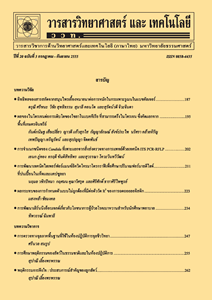ผลของความเข้มข้นสารตั้งต้นต่อลักษณะทางสัณฐานวิทยาและสมบัติการเร่งปฏิกิริยาด้วยแสงของแท่งนาโนซิงค์ออกไซด์ที่เตรียมโดยวิธีไฮโดรเทอร์มอล
Main Article Content
Abstract
ZnO nanorods (ZNRs) were grown onto silicon wafer substrates by hydrothermal method from different concentrations of precursors (zinc nitrate hexahydrate: hexamethylenetetramine) between 5-30 mM. It was found that the precursor concentrations affected the morphologies of ZNRs by increasing the length and diameter when the precursor concentrations were increased. These resulted morphologies depend on the crystal plane as understood in terms of the difference of critical concentrations between (0001) and (1010) planes, which related to the different surface energies between the crystal planes. The well-defined structures of ZNRs with high aspect ratio (AR) were successfully fabricated by hydrothermal method for precursor concentration of 10 mM. This best sample showed the superhydrophilic property after UV irradiation for 1 hour.
Article Details
References
[2] Katayama, J., Ito, K., Matsuoka, M. and Tamaki, J., 2004, Performance of Cu2O/ZnO solar cell prepared by two-step electrodeposition, J. Appl. Electrochem. 34: 687-692.
[3] Ahn, M.W., Park, K.S., Heo, J.H., Park, J.G., Kim, D.W., Choi, K.J., Lee, J.H. and Hong, S.H., 2008, Gas sensing properties of defect-controlled ZnO-nanowire gas sensor, Appl. Phys. Lett. 93: 263103.
[4] Tian, C., Zhang, Q., Wu, A., Jiang, M.,
Liang, Z., Jiang, B. and Fu, H., 2012, Cost-effective large-scale synthesis of ZnO photocatalyst with excellent performance for dye photodegradation, Chem. Commun. 48: 2858-2860.
[5] Yang, K.Y., Yoon, K.M., Choi, K.W. and Lee, H., 2009, The direct nano-patterning of ZnO using nanoimprint lithography with ZnO-sol and thermal annealing, Micro electron. Eng. 86: 2228-2231.
[6] Wahab, H.A., Salama, A.A., El-Saeid, A.A., Nur, O., Willander, M. and Battisha, I.K., 2013, Optical, structural and morphological studies of (ZnO) nano-rod thin films for biosensor applications using sol gel technique, Results Phys. 3: 46-51.
[7] Kim, M.S., Yim, K.G., Choi, H.Y., Cho, M.Y., Kim, G.S., Jeon, S.M., Lee, D.Y., Kim, J.S., Kim, J.S., Son, J.S., Lee, J.L. and Leem, J.Y., 2011, Thermal annealing effects of MBE-seed-layers on properties of ZnO nanorods grown by hydrothermal method, J. Cryst. Growth 326: 195-199.
[8] Polsongkram, D., Chamninok, P., Pukird, S., Chow, L., Lupan, O., Chai, G. and Schulte, A., 2008, Effect of synthesis conditions on the growth of ZnO nanorods via hydrothermal method, Phys. B Condens. Matter. 403: 3713-3717.
[9] He, Y., Yanagida, T., Nagashima, K., Zhuge, F., Meng, G., Xu, B., Klamchuen, A., Rahong, S., Kanai, M., Li, X., Suzuki, M., Kai, S. and Kawai, T., 2013, Crystal-plane dependence of critical concentration for nucleation on hydrothermal ZnO nanowires, J. Phys. Chem. 117: 1197-1203.
[10] Ashraf, M., Champagne, P., Campagne, C., Perwuelz, A., Dumont, F. and Leriche, A., 2016, Study the multi self cleaning characteristics of ZnO nanorods functionalized polyester fabric, J. Ind.
Text. 45: 1440-1456.
[11] Sun, L., Zhao, D., Song, Z., Shan, C., Zhang, Z., Li, B. and Shen, D., 2011, Gold nanoparticles modified ZnO nanorods with improved photocatalytic activity, J. Colloid Interface Sci. 363: 175-181.
[12] Kalasung, S., Kopwitthaya, A., Horprathum, M., Kaewkhao, J., Tuscharoen, S., Eiamchai, P., Witit-anun, N. and Aiempanakit, K., 2016, Functionalization of Au nano particles on ZnO nanorods through low-temperature synthesis, Key Eng. Mat. 675-676: 45-48.
[13] Shaziman, S., Ismail@rosdi, A.S., Mamat, M.H. and Zoolfakar, A.S., 2015, Influence of growth time and temperature on the morphology of ZnO nanorods via hydrothermal, Mater. Sci. Eng. 99: 12-16.
[14] Guo, M., Diao, P. and Cai, S., 2007, Highly hydrophilic and superhydrophobic ZnO nanorod array films, Thin Solid Films 515: 7162-7166.


